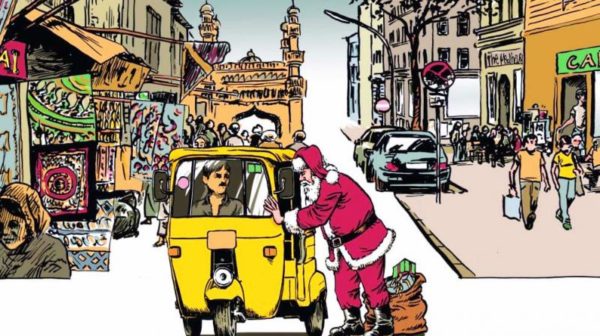When different cultures collaborate to create artwork, the result can be sheer magic. As part of the ongoing Hamburg Hyderabad Project, German artist Fabian Stoltz collaborated with Hyderabad-based graphic writer Jai Undurti to work on a graphic novel to highlight two drastically different cultures and how India and Germany came together on the battleground during WWI.
“It is a very unique project for us. Both the artists have very different styles but as they worked together, their chemistry grew. Jai went to Germany in 2017 to meet Fabian and stayed there for a couple of weeks to discuss the work and create the story line. A few months on, Fabian too came here to know about Hyderabad and its culture,” shares Amita Desai, Director, Goethe Zentrum Hyderabad, who coordinated the exchange.
For Jai, who is more into urban contemporary fantasy writing, the whole exercise was very intriguing, while for Fabian, who is predominantly interested in social and political themes, it was a whole new universe to discover. “When two people are working together both their strengths and weaknesses comes into play. Our work is a perfect amalgamation of both of our work styles,” says Jai. In resonance with the same sentiment, Fabian says, “The collaboration is a challenge. We communicate via mail and skype from time to time. When we meet, we go walking and exchange our thoughts, or sit down, have a coffee. Usually I start with writing down the story, then doing scribbles and finally the inking. In this case, it is more of a back and forth. Especially when Jai was at our working hub in Hamburg before the exhibition, he would come up with ideas while I was already drawing. These I then added into the pages.” He adds, “Our work is still in progress.”
The double spread artwork showcasing the Charminar and Elbphilharmonie in Germany.
What was initially a 13-page graphic book, went on to become a 17-pager and is at present being planned to have approximately 50 pages. The idea was to keep the original pages and add new ones, but as it has turned out, there are only two original pages left now.
The story idea too has become so vast that it won’t fit into the 50 pages, so the two are doing the first part only currently. The most interesting piece of artwork in the ever increasing graphic novel is a double page spread inspired by images one can find in children’s books called Wimmelbild (bustle picture) in German. Lots of different things are happening and there is plenty for the eye to look at. Especially the panoramic view of Hamburg, that is quite iconic, intertwined with the Charminar and the serpents.
“I enjoy the spread because all the Indians recognise the Charminar but don’t know about the building it is set upon, while in Hamburg everybody knows the freshly inaugurated Elbphilharmonie but people would ask what is set on top of it,” says Fabian.
Another artwork from the series which caught the eye was that of Santa Claus bending and negotiating with an auto driver right in front of Charminar. “The post card was created during Christmas by both Fabian and Jai. It is interesting to see how Fabian got the nuances on-spot. The way we generally talk to auto drivers to negotiate. On one side of the street is the quintessential Charminar market and on the other a posh German market street coming alive beautifully together,” says Amita. The dynamic duo’s immense sense of humour has helped them capture such small nuances to the point, and make the graphics come alive and tell a story of their own.



Leave a reply